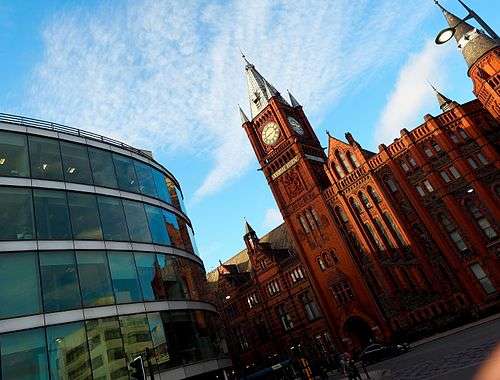University of Liverpool School of Medicine
Coordinates: 53°24′25″N 2°58′01″W / 53.407°N 2.967°W
 Cedar House (above) is the main Medical School building. | |
| Type | Public Medical School |
|---|---|
| Established | 1825, Incorporated 1903 |
| Undergraduates | circa 1,800 |
| Postgraduates | circa 1,200 |
| Location | Liverpool, England, United Kingdom |
| Campus | Urban |
| Dean | Vikram Jha |
| Affiliations | General Medical Council |
| Website |
www |
 | |
The University of Liverpool School of Medicine is a medical school located in Liverpool, United Kingdom and a part of the University of Liverpool. It is one of the largest medical schools in the UK, and in 1903 became one of the first to be incorporated into a university.
The school used to have a problem-based learning curriculum, which was replaced in 2014 with a new 'integrated' curriculum for its flagship 5 year MBChB course, which has an annual intake of 280 students. Around 1800 medical undergraduates and 1200 taught postgraduates study at the school at any one time. The school also offers an MD programme and courses for continuing professional development.
History
The medical school pre-dates the University of Liverpool. When the University received its royal charter in 1903, the medical school was incorporated into the University. Originally the school only accepted males onto its medical course, it allowed females to be admitted in 1905. The associated Liverpool School of Tropical Medicine was the first school of Tropical Medicine in the world.
In 2011 following an internal restructure of the University, the Faculty of Medicine was demoted back to School status under the stewardship of the new Faculty of Health and Life Sciences.
Facilities
The school's facilities have recently undergone a massive refurbishment and redevelopment. The refurbished Liverpool Royal Infirmary Waterhouse buildings house the Clinical Skills Resource Centre for clinical teaching, and a centre for the development of personalised medicine. The school also makes use of a Human Anatomy Resource Centre for anatomy teaching.
The School of Medicine is based in the 19th century Cedar House building on Ashton Street. Cedar House includes teaching rooms, administrative offices for the senior management, and a medical student common room.
Teaching hospitals
The medical school has close links with the region's NHS organisations, which are actively involved in designing its courses and in hosting students for the practical aspects of training. Hospitals include: Royal Liverpool University Hospital, Broadgreen Hospital, Whiston Hospital, Aintree University Hospital, The Walton Centre for Neurology and Neurosurgery, Arrowe Park Hospital, Liverpool Women's Hospital, Countess of Chester Hospital and Alder Hey Children's Hospital. The medical school also has close links with the Liverpool School of Tropical Medicine.
Courses
The School provides undergraduate and postgraduate courses in medicine.
In 2011 there were around 1,800 undergraduate students enrolled on the MBChB course and 1200 taught postgraduates
For the 5 year A100 course, the current conditional offer given to a student taking A-Level examinations is AAA(b), to include Biology and Chemistry at A-Level. Candidates are required to sit the UKCAT examination. The style of interviews is MMI (Multiple Mini Interviews).
As with all UK Medical Students, successful applicants must be immunised against Hepatitis B, Diphtheria, Polio, Rubella, Tetanus, Varicella and Tuberculosis.
Notable alumni
Alumni include:
- Lord Henry Cohen (21 February 1900 – 7 August 1977), a prominent lecturer at the medical school and taught there for over 5 decades
- Sir Charles Scott Sherrington, the discoverer of the synapse.
